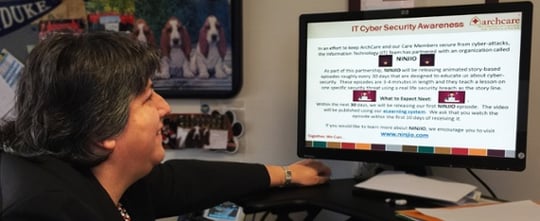How ArchCare Improved Operational Awareness, Staff Engagement And Focus

Our Customer
ArchCare is a major not-for-profit provider of home and community-based healthcare programs
Their Industry
Healthcare
Location
New York, United States
Number of Employees
3,000 across 24 sites
Background
It’s no secret that one of the toughest challenges in the healthcare sector is effective employee communications. The topics can be so vast: from hospital codes and changes in procedures or regulations, to more passive content around building culture and employee news. In certain cases, a missed or late communication could literally mean the difference between life and death.
Other factors, like shift patterns and employee diversity – such as age, education and location - all add further considerations when trying to get an important message through at the right time.
Chief Information Officer Mitze Amoroso knows this only too well. Along with her team of 18, Mitze oversees all aspects of IT at ArchCare, a large provider of in-home and community-based healthcare programs, nursing homes and hospitals in New York and the wider region.
As well as ensuring everything from infrastructure and cyber security are taken care of 24/7, she pays great attention to how the 3,000 employees across ArchCare’s 24 sites are kept up-to-date.
Key Challenges
Employee communication plays a critical role in achieving ArchCare’s strategic plan: CORE (Communication - Organizational well-being – Recognition – Education). To perform well in these four areas, Ms Amoroso and the leadership team recognized that fresh thinking was urgently needed to engage and communicate better with every employee.
Faced with concerns surrounding information overload and poor staff response rates to email, Ms Amoroso set about exploring alternative ways to communicate.
The main challenges she encountered were getting information in front of employees quickly, improving response rates to internal communications, keeping communication noise to a minimum, and reaching a dispersed workforce many operating on shifts.
The solution they needed would allow them to improve message cut-through so that important news reached the right people at the right time, and to track what was getting read to learn which types of content type engage employees better.
Solution
To deliver important information direct to employees in a much better, faster and quiet way, Archcare introduced the SnapComms platform. A range of channels were selected to handle every communication need, from high-priority to longer-term behavioral.
Desktop Alerts deliver high-priority messages or announcements directly to desktop and mobile devices. Messages can override all other applications depending on the severity of the situation.
Desktop Tickers are newsfeed-style scrolling text across the bottom of employees’ computer screens, providing high visibility but low intrusion. Hyperlinks can be included to direct staff to their intranet for more details.
Screensavers are passive yet powerful tools, with strong visuals and high repetition for promoting organization values, events or reminders.
RSVP alerts improve the efficacy of training programs by encouraging high staff response rates and attendance.
Tools Implemented
Application
Each of the SnapComms channels were customized with ArchCare’s branding and are used almost on a daily basis.
Ms Amoroso explains: “We started off looking for a better format to publish our daily patient census.”
Instead of emailing this information (which shows new enrolments and is referenced by many teams), ArchCare began pushing census information out via a daily desktop alert on trial from SnapComms.
Using the new tools, ArchCare could now match specific communication objectives with an appropriate channel designed to suit purpose.
For example, in any unplanned event, such as a network outage or an emergency situation, desktop alerts prove ideal, as these pop up directly onto the employee’s screen and get read straight away.
For future events, including a deadline to complete an important task, ArchCare now uses tickers. These scroll across the bottom of the employee’s screen and act as effective prompts.
For ongoing communication tasks, such as operational reminders regarding hand hygiene and infection control, or general news items – such as photos from celebrations, CEO announcements or staff recognition awards – screensavers are ideal.
As Ms Amoroso explains, “These images are on rotation and are regularly updated by our communications team. Screensavers are a popular format because they’re so visual and always present, albeit in the background; I often hear colleagues commenting on these, obviously engaged with what they’re seeing."

As a side note, Ms Amoroso comments she also uses screensavers to remind her own team of the key projects they’re working on. “It avoids any misunderstanding or excuse for not knowing where their focus is; our priorities are clearly outlined on a screensaver that’s right in front of them.”
For specific themes, particularly those which require behavioral change, ArchCare combines all its channels and creates a ‘campaign’ to really drive a message home.
This proved highly effective in the switchover from ICD 9 to ICD 10 (International Classification of Diseases). ArchCare created a countdown campaign e.g. “Five days until ICD 10” using a series of scrolling tickers and screensavers. Again, these were delivered direct to employees’ screens, and updated daily in readiness for a smooth transition.
Another example is ArchCare's communication program to increase security awareness and promote a culture of safe online behavior. Ms Amoroso says: “Staff play such an important part in preventing a cyber security breach. They are the first line of defence. This requires a sustained internal communications program.
"We’ve established an effective way to lift staff awareness levels across important cyber security topics using a variety of communication formats, such as video, screensavers and alerts via SnapComms’ tools. Taking a ‘campaign’ approach has delivered great results for us; undoubtedly our staff are better informed and we’ve minimized our risk."
Results
One of the most surprising benefits of the SnapComms platform is the drastic drop in calls to the IT Helpdesk. “We recently had an unexpected outage at one of our sites. Straight away we sent an alert to those affected, and followed this with regular status updates,” Ms Amoroso adds.
This proactive approach eliminated the usual deluge of concerned callers. “Previously, our Helpdesk team would have been inundated with calls, saying the same thing over and over. Instead, we were able to focus on the problem in hand and fix it much sooner.”
Since ArchCare introduced SnapComms, Ms Amoroso admits it’s evolved more than she originally anticipated. “We’re using SnapComms tools for all our communications now – not just for census and IT outages – but for everyday items too.”
Being able to track and measure employee open and click through rates, particularly surrounding the important areas of compliance, has enabled ArchCare to discover what works and what doesn’t, to identify gaps, and to validate employee training.
“Messages get through quietly, without the need for noisy overhead announcements - an important factor for our environment."
We’re finally getting the message cut through that’s so essential for our employees, and ultimately for the patients we care for.

